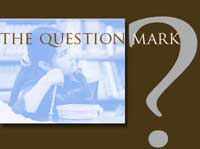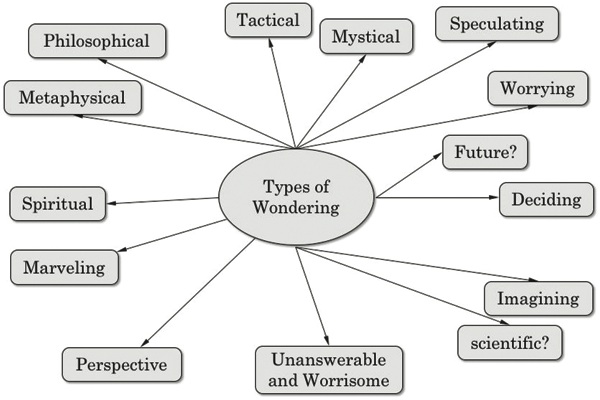| Research Cycle |
|
|
|
| Vol 8|No4|April |2012 | |
Note: This article is Chapter Ten of Jamie's most recent book, Lost and Found. Quietude and its relationship
| |||||||||||||||||||||||
|
Deep time? In this current culture of buzz, rush and connectedness, how much deep time does anyone enjoy? Just what is deep time and what are its benefits? |
Deep time is closely related to deep thinking, as Birkerts suggests above. They feed on each other and support each other. Take Otis Redding’s song, Sitting on the Dock of the Bay
This is hardly wasting time. It is this kind of sitting that allows the mind to wander, to wonder and to speculate. During the past few years I have asked dozens of audiences to list when they are most likely to find their mind wandering and wondering. They have listed the following, along with many others:
During these times when the mind wanders and the person wonders, I found that there were hundreds of questions that people wondered about. They were curious about their children’s future and the world’s future. These being mostly teachers, they wondered how much longer decision-makers would flirt with high-stakes testing as a reform strategy. Their questions fell into a dozen categories captured by the diagram below.
Stillness allows the mind to open and taste possibilities that may otherwise remain buried. When we rush about physically from spot to spot and task to task, when our thoughts dart from project to project, insights that dwell at deeper levels of consciousness rarely surface to win our attention. Ideas that are simmering may never materialize. Even worse, the simmering may not occur at all if the mind’s pilot light has not been activated. A fundamental message of this chapter is the importance of awareness. If the thinker knows about this kind of thinking, she or he can learn to kindle imaginative fires. Sadly, it is rare that schools will educate the young about incubation and reverie.
Much of our most imaginative thinking will occur in dream states that are elusive. Although this process of kindling is nowhere near as reliable as turning on a radio or an iPad, it is possible with practice to nurture such states of mind and to make incubation flourish in the background throughout many hours of the day and night.
Calling on muses Writers and composers have been calling upon muses for centuries with only partial success. In Shakespeare’s 79th sonnet, he complains that his poetry has suffered since his muse has sickened.
If you Google the phrase “calling on the muse,” it is easy to find sites, articles, products and seminars designed to assist earnest poets, writers, thinkers and dreamers who have been frustrated in their at- tempts to summon the muses. Exercises to Unlock the Poet Within is just one example I found on the morning I was writing this section. Some of these offerings seem a bit gimmicky, but it is clear that many creative types are seeking inspiration—hoping to find a catalyst to spark their artistry. Key to this challenge is the quieting of the mind’s analytical chatter. Though analysis is an important aspect of thinking, it has a way of stifling the more imaginative modes. The thinker must learn to switch modes so the mind can operate in the most productive manner for the task at hand. While many view the muse as some magical influence coming from the outside, this book looks at the muse as an internal resource available for consultation and assistance once the thinker learns how to gain access. Sometimes this switching of modes is best achieved through a change of activities and settings, as when the thinker stands up to leave the laptop and desk behind while heading out the door for a brisk walk or run along the shore of the lake—or sits on the dock of the bay for an hour or so, seemingly wasting time. Contemplation is closely associated with mental activities such as meditation, rumination and reverie, all of which flourish when both body and mind are at rest. There are many ways to achieve this mood and the stillness required—the quietude that might enable us to generate and then harvest intriguing insights. Sadly, wondering and dreaming are fundamental components of the reflective mode that have been supplanted and shoved aside by many of the currently popular cultural trends and fads. “Leave the driving to us!” (a slogan for the Greyhound bus line) now extends to thinking, dreaming and imagining, as the Web offers charming little widgets that perform many previously imaginative or creative tasks for the user without requiring any real thought or involvement.
Struggling to come up with a poem about stillness and quietude? Go to runokone.com/makeapoem/index.php
Genuine art, thinking, imagining and inventing do require skill and effort. The apps offer some cute special effects, but they rarely produce the “extraordinary art” claimed. Learning to go unplugged
We are so wired a hundred years after Kandinsky wrote the above, that the possibility of going unplugged seems an almost impossible dream from an earlier age. The average person is so thoroughly smartphoned that there are few hours or minutes without connection. In all of the listings published as 21st Century Skills, I have not seen “learning to go unplugged,” but creative thinkers must learn when to turn devices on and off. Even as I write this paragraph and the next, I have been listening to a hard driving band, Lifehouse, playing a song, “Disarray.” Their loud and insistent music is preferable to the babble in the coffee house where I am working. One noise has cancelled another. The jury is out on the multi-tasking capabilities of both adults and teenagers, with some like Nicholas Carr arguing in The Shallows: What the Internet Is Doing to Our Brains that connectedness and constant interruptions can hurt productivity. Lined up in opposition to his worries are dozens of others who write optimistically of the benefits of connectedness. In The New York Times on November 21, 2010, Matt Richtel reported in “Growing Up Digital, Wired for Distraction” that “Students have always faced distractions and time-wasters. But computers and cell phones, and the constant stream of stimuli they offer, pose a profound new challenge to focusing and learning.” His article goes on to describe the technology habits of students at Woodside High School in California. It is not a pretty picture, as digital devices have seduced many students away from quality work and school success. Despite the claims of some technology enthusiasts and many young people, there is some evidence that this generation is not so good at multitasking as it would like to believe. In his article, “Combating Mental Brownout,” Jeff King, the Director of the Koehler Center at Texas Christian University, warns that students are not so good at multitasking. King employs the term “Mental Brownout” to describe the decline in performance that goes along with multitasking:
He has created a two-sided page for students at his university summarizing the risks of multitasking.
King’s videos are available online: Similar findings and concerns are voiced in the PBS special, Frontline’s program “Distracted by Everything.” Despite growing evidence that digital might be sometimes distracting, many schools and students steam forward a bit like the Titanic, asking few questions, raising few issues and “drinking the Kool-Aid” as MIT professor Sherry Turkle calls it in her interview for Digital Nation - Life on the Virtual Frontier.
Turkle’s latest book, Alone Together: Why We Expect More from Technology and Less from Each Other, raises major concerns about the impact of these technologies on human relationships. The Pew study, Teens and Mobile Phones, reports that 84 per cent of teenagers who own cell phones have slept with their phone next to their bed or in bed with them. Irish poet John O’Donohue devoted a section of his book, Beauty: The Invisible Embrace, to an analysis of how things digital may dilute experience and take us away from the beautiful. This chapter offers quietude and stillness as promising antidotes to this hyperactive lifestyle that some have labeled as a “Technology Attention Deficit Disorder.” Finding a sacred place Joseph Campbell suggested in his books and in interviews that each person identify one or more sacred place in which to foster deep and reflective thinking.
Campbell did not actually require a physical space so much as a mood and state of mind. It might be at the end of the dock of the bay mentioned earlier. It might be in a forest clearing. Perhaps a mountain pond ten miles from the nearest highway or road? Or maybe a tree house or a Monet bench in your own backyard, cut off from distraction by a tall hedge? It might be a quiet corner of the living room when the house or apartment is empty except for you. It can even be in the midst of a crowd. Finding sacred music Campbell is quick to connect music with the sacred place:
Some people prefer to rotate and change the music much as was described in the chapter on shuffling. Others have favorite collections that can be counted upon to put them in a reflective mood without much effort—almost working like a pre-hypnotic suggestion.
Different kinds of music may also provoke different kinds of thought and incubation. Because the process is highly personal, each person has to play around with different genres until happy with the results. Ideally, the results become somewhat predictable.
Finding the time Campbell also suggests that each person set aside time every day for this kind of reflection. One cultivates the routines and habits of deep thought as a counterbalance against the frenzy and interruptions of current culture. In this way, we avoid the thinness O’Donohue warns against and we stay closer to our spirit and our heart. Many people find it difficult to find time for reading or exercise these days, let alone some form of meditation and deep thought. The statistics on current lifestyles are not heartening—though many seem quite capable of finding time for television programs and second digital lives. Riding a bus or a train, there are plenty of people to be seen zoning out with a book or some music. While they may not be using this time to incubate important ideas or work on creative challenges, they have found a way to tune out the madding crowd even when the roar of the subway car might seem to make such concentration impossible. Those who ride the treadmill, the elliptical trainer or the exercise bike may find that this time spurs the kind of deep thinking suggested in this chapter. I know that some of my best writing takes place—in the sense of idea processing—while I am off on a long run down some forest trail. This same kind of thinking and composing may also occur in a gym or a home. Regularly scheduled exercise can provide both the time and the condition to foster incubation and deep thought. FNO Press is applying for formal copyright registration for articles.
|
||||||||||||||||||||



